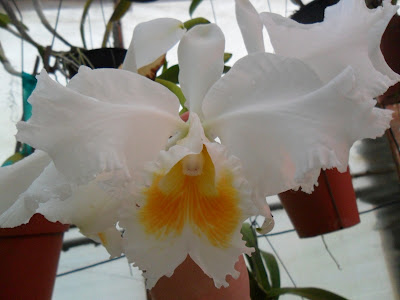I have been very busy flasking many more different species from various parts of the world as well as some of our local species. I will post some flask pics soon when I have a moment to remove some to photograph. I harvested my Phalaenopsis hieroglyphica pod after 7 months on the mother plant. It was still green but I decided to remove it because the plant was stressing a bit. The pod was full of ripe seeds and I hope they germinate well in the weeks to come.
I have included a few images of a very large white Cattleya, C. quicksilver, an old hybrid registered in 1963 from seed parent C. Dorothy Mackaill and pollen parent C. White blossom. I have since crossed this one with my flowering Rhyncholaelia hybrid so it will be interesting to see if it works.
Two new Phalaenopsis species arrived last week from Nollie, P. lindenii and P. lowii. I mounted both plants onto cork rafts and have placed them with some of the other more demanding species on the mounts wall in the greenhouse. The P. lowii originated from Europe and as a result it is in a state of dormancy. In fact this is one of the only species of Phalaeanopsis that will actually undergo a state of dormancy and lose its leaves. My plant has a single leaf which remains so I do hope that it recovers. I am looking forward to some flowers of both species in the years to come.
 |
| Cattleya quicksliver dorsal view |



I love the mottled look of lindenii leaves. Interesting about phal lowii dormancy, does it require any change in care when dormant?
ReplyDeleteHi Orchideya. Thanks for your comments. This is the fisrt time I have attempted P. lowii although I do have some seedlings developing in flasks from small protocorms presently. I understand that this species undergoes dormancy in cooler conditions but that it can be kept active if given constantly warm conditions. My specimen originated from Europe where it is somewhat cooler than it is here. I hope that by providing a warm and humid environment now it will become active again. With other orchids, a period of dormancy usually means that the pant requires much less watering and no fertiliser until active again.
ReplyDelete